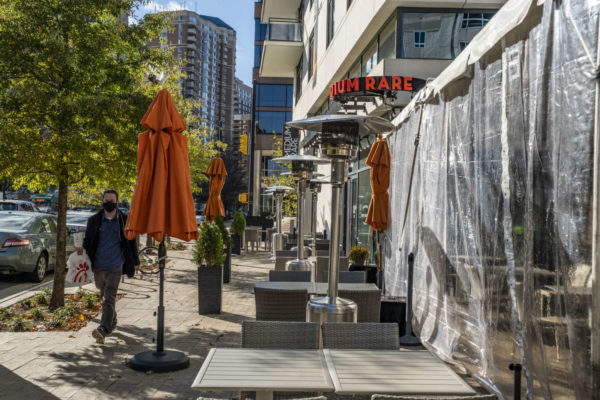Arlington County is looking to make a three-block stretch in Courthouse safer for pedestrians, cyclists and motorists.
Specifically, it is looking for ways to improve conditions along a three-block stretch of Wilson Blvd and Clarendon Blvd between N. Uhle Street and N. Adams Street.
The county says the overall project goal is to “create a safe and consistent travel experience for people walking, taking transit, biking, and driving through the Courthouse section of the Rosslyn-Ballston corridor,” which has a lot of pedestrian, transit and micro-mobility activity.
Through this Sunday, the county is asking people to share their current experiences as road users and what upgrades matter to them.
When it comes to government priorities, safety is a top concern. The county says Clarendon and Wilson Blvd have seen a higher concentration of critical crashes in recent years.
They are included in a “High Injury Network,” a designation the county uses to prioritize adding transportation safety features to its least-safe roads. This is part of Arlington’s Vision Zero initiative to eliminate fatal and severe-injury crashes by 2030.
Within the project’s boundaries, there was a pedestrian crash with severe injuries on Clarendon Blvd in 2015, per a dashboard of crashes with severe and fatal injuries. One block east of the intersection with N. Uhle Street, there was a fatal pedestrian crash in 2014.
Another aim is to fill a “missing link” in bicycling facilities. Clarendon and Wilson Blvd are identified as “primary bicycling corridors” in the county’s Master Transportation Plan, as is N. Veitch Street, which connects cyclists to Langston Blvd, the Custis Trail and the Arlington Blvd Trail.
The county says it aims to realize community visions for better walking, cycling and transit experiences in Courthouse with new curbs and ramps for people with disabilities and improved bus stops and facilities near the Courthouse Metro station.
To encourage (proper) use of shared e-bikes and scooters, the county will review and provide “adequate end of trip facilities.” That could look like the corrals it has installed elsewhere in the Rosslyn-Ballston corridor and in Crystal City and Pentagon City.
Whatever improvements are selected would link to upcoming road resurfacing work. The county previously incorporated small upgrades when it resurfaced Clarendon Blvd from Courthouse Road and N. Scott Street and from N. Garfield Street to N. Adams Street.
The improvements would also link to street upgrades developer Greystar is delivering via its under-construction Landmark development (2050 Wilson Blvd), set to wrap up this fall, and its redevelopment on the former Wendy’s site (2025 Clarendon Blvd).
Those projects will bring about:
- A “bike island” at the intersection of 15th Street N. and Clarendon Blvd, as well as more and wider protected and dedicated bike lanes
- Wider sidewalks
- Improving pedestrian crossings of Wilson Blvd and Clarendon Blvd
- Two new “floating” bus stops
- A pedestrian promenade along N. Uhle Street from Clarendon Blvd and 15th Street N.
- Relocated and newly installed traffic signals
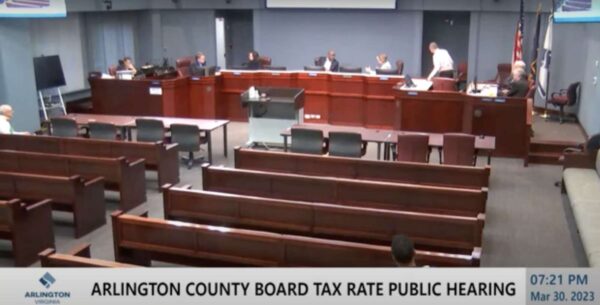
Have you ever showed up to a date and realized you had been stood up?
The Arlington County Board nearly did yesterday (Thursday) during a hearing on the proposed property tax rate.
The county proposes a rate of $1.013 per $100 in assessed value. While flat over last year, the average Arlington homeowner would still see taxes go up $454, owing to rising residential property assessments and other fees.
“Madame Clerk, do we have any speakers this evening?” asked Board Chair Christian Dorsey.
“We do. We have one speaker,” said the clerk.
“Terrific,” he rejoined.
That speaker was Hamilton Humes, the commissioner of the Youth Ultimate League of Arlington, an ultimate frisbee league. Addressing the board in gear suggesting he had just been out slinging a disc — or would be soon — he expressed his thanks for the County Board’s work and approval for the fees levied to maintain local playing fields.
“We appreciate all the effort to provide playing fields,” said Humes. “I speak for all the youth athletic organizations to say that… The only issue, which is not in your purview, is the scheduling between Arlington Public Schools and the Dept. of Parks and Recreation, but you all know that.”
There was no mention of the property tax rate.
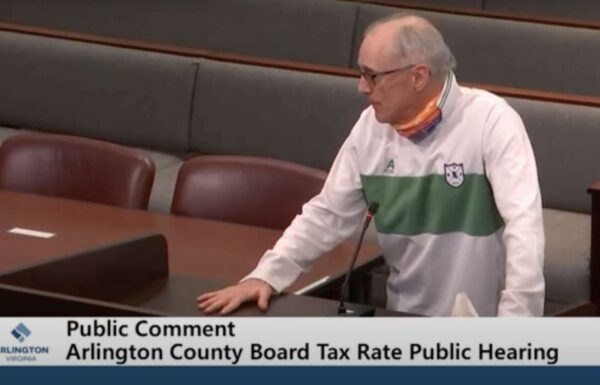
The Board took a break to wait for more speakers. Eventually, a man called in to ask why the real estate assessment on a church property he recently purchased along Route 50 had increased by more than 17% — compared to increases of 3.5.-5.5% in previous years.
He prefaced his brief comments by apologizing for possibly bringing this up in the wrong avenue, saying he had never done anything like this before. After he finished speaking he was informed that it was, in fact, the wrong venue for challenging property assessments.
“We have a no wrong door policy,” Dorsey assured him. “We’ll be sure to communicate with you via email about the exact route for [appealing the tax assessment]. We’re happy you joined us however you come to us.”
Last night’s meeting is a far cry from Missing Middle hearings last week, which saw north of 200 speakers, as well as yesteryear’s tax rate hearings. A hearing in 2010 drew 26 speakers, the most of any meeting dating back to 2008 with minutes available on the county website.
In these meetings, people often requested higher taxes to cover school spending or affordable housing, while others have advocated for lower tax rates or holding the current tax rate steady to provide relief to people on fixed incomes and small business owners. Those opposed to tax hikes would often also speak in favor of reducing county spending.
The number of speakers has since declined to seven, four and six speakers in 2020, 2021 and 2022, respectively — years that coincided with introspection and concern about the county’s pathways for citizen engagement, called the “Arlington Way.”
Meeting minutes showed about a half-dozen people who used to speak reliably against increases: In first place, with at least eight appearances, is former independent Congressional candidate Jim Hurysz; in second is former independent County Board candidate Audrey Clement, with at least seven.
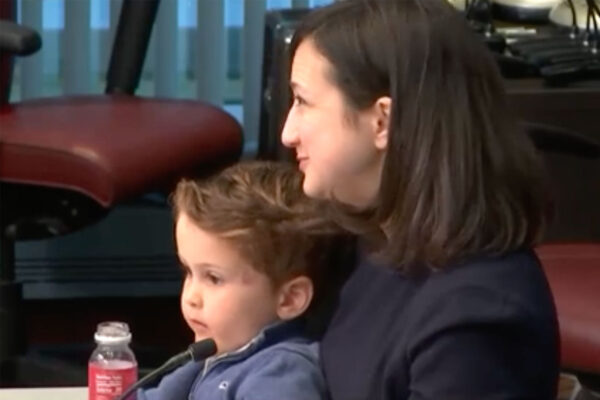
While lacking in speakers passionate about taxes and county finances, the meeting had one memorable moment.
Arlington’s youngest-ever Sergeant-At-Arms — County Board member Katie Cristol’s son — banged the gavel to start the hearing at 7 p.m. As he continued banging the gavel, Cristol intervened.
“Okay, you don’t have to keep doing it,” she said.
He happily sat on Cristol’s lap, sipping juice until his father took him home. Board members continued chatting among themselves between the speakers and the adjournment at 8 p.m. sharp.
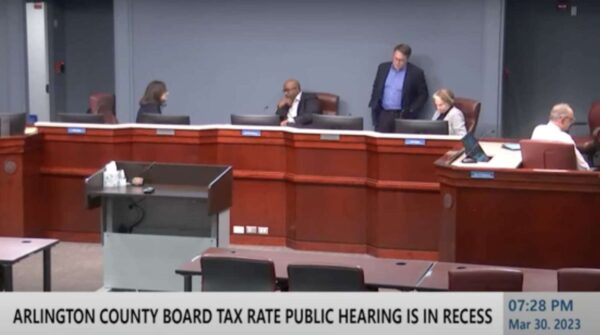
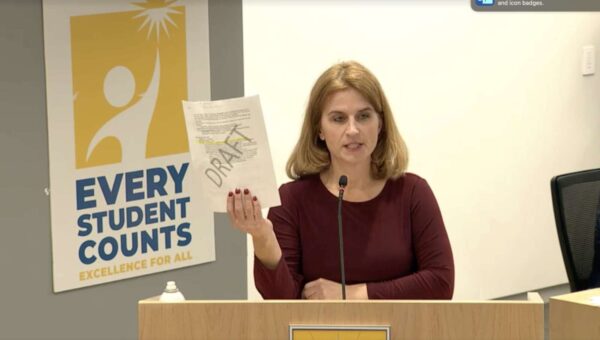
(Updated at 4:25 p.m.) After lockdowns, a fatal, apparent drug overdose, a racist threat of gun violence, and additional threats and gun-related incidents — all within the past few weeks — parents and teachers say they want more information from Arlington Public Schools.
But there’s a document floating around — outlining how School Board members should talk to the public, school staff, other board members and members of the media — that they say encourages the Board to be less transparent.
June Prakash, the president of Arlington’s teachers union, the Arlington Education Association, bashed the document as part of her remarks outlining steps APS can take to improve school safety.
“We need to tear up this ‘How We Work’ document from Board Docs,” she said in a School Board meeting on Thursday, garnering applause from people who attended the meeting.
The document, prepared by School Board Chair Reid Goldstein, was meant to serve as a discussion guide for a retreat a few weeks ago to onboard the newest member, Bethany Sutton.
It tells members to:
- Avoid conversations about workplace conditions with staff members without appropriate union representatives present.
- “Err on the side of vague” when talking to the community. Officials should refer them to previous public discussions where possible and if none exists, say they’ll bring the issue to the rest of the Board.
- Tell the Chair if they “are contemplating” responding to press inquiries and instead let the School & Community Relations staff advise them.
“The document was a discussion guide prepared by the Board Chair to advise Board members about responding to questions about topics that they don’t have full information on,” APS spokesperson Frank Bellavia told ARLnow. “The Board receives many questions about pending decisions or other operational topics that they have yet to be fully briefed on. The guidance meant that it is okay to say, ‘I don’t know and I will get back to you,’ versus a specific response each time.”
He added that the memo “is not and will not become policy,” and that community members have several ways to engage directly with School Board members, including member office hours.
Media inquiries are handled through dedicated APS staffers for efficiency’s sake, but this approach is reviewed annually, Bellavia noted.
Prakash, however, tells ARLnow that the AEA is disappointed in the document, while the APS watchdog group Arlington Parents for Education says these instructions will erode the trust parents have in their elected officials.
“How can you ethically say, ‘Don’t talk — or even listen — to staff members about working conditions? You need to visit the schools, you need to listen to talk to the students and the staff. When you start listening, they’ll start talking,” Prakash said Thursday.
Last year neighboring Alexandria’s public school system was roiled by a series of events that included a School Board policy — since revised — that discouraged members from talking to the media, and the superintendent advising members not to talk to the media about a fatal stabbing. Superintendent Gregory Hutchings abruptly resigned shortly thereafter.
During the Arlington School Board meeting, members discussed how the guidance in the document applied to collective bargaining discussions but not regular engagement with staff, according to Bellavia.
“There is no direction for the Board not to listen to staff, or any other members of the community,” he said. “In fact, the Board has affirmatively stated that they want to hear from staff. The Board Chair acknowledges that it was poorly worded in the handout.”
Arlington Parents for Education said in a statement that the memo “reflects a keen reluctance to engage in clear, honest and frank discussion with the APS community, including parents, teachers and administrators.”
“We urge the Board to commit itself to a greater level of candor in its dealings with all stakeholders, and to publicly disavow the guidance and the sentiment behind it, which implies that community members are problems to be managed and not stakeholders who the Board is elected to represent,” APE said.
Proposed Missing Middle zoning code changes are set to go before the Arlington County Board for a first look on Saturday.
The Board is slated to review a request to advertise public hearings on a proposal to allow the by-right construction of duplexes, three-unit townhouses and multi-family buildings with up to six or eight dwellings on lots of up to one acre in Arlington’s lowest-density zoning districts.
The proposal includes several options for regulating the number of so-called “expanded housing option uses” (EHOs) built per year, their density and size, and parking and tree canopy coverage.
If Board members approve this request to advertise (RTA), the Arlington County Planning Commission and the County Board will have two months to pick a slate of regulatory mechanisms before holding hearings and, potentially, adopting the proposal in March.
Ahead of the request to advertise, Arlington County warned that speaking times may be shortened on account of the intense public interest in the wide-ranging changes.
“If 75 or more speakers sign up to speak on one item, speaking times will be reduced to 2 minutes for all individuals and 3 minutes for all organizations,” the announcement said. “Speakers will be notified if speaking times change.”
The County Board members adopted an ordinance allowing such time reductions last month, after droves of residents came out to speak about Missing Middle in meetings over the last year.
In addition to possibly shortening speaking times, the county will prioritize hearing from different speakers this month and in March.
“When people sign up to speak at the March public hearing, the Clerk’s staff will identify those that did not speak in January and place them first in the speaking order, followed by anyone that spoke did speak at the January hearing,” county spokesman Ryan Hudson said. “Anyone that signs up to speak will have the opportunity to do so.”
Ahead of the meeting, Missing Middle proponent group YIMBYs of Northern Virginia said this RTA has been years in the making. It says development under this plan will be as “distributed [and] gradual,” but that the county has to start somewhere.
“To further improve affordability, Arlington policymakers can revisit regulations such as height limits in the future, but they must start by legalizing up to 8 units per lot with minimal regulatory burdens, which requires maximum flexibility in the RTA,” the group said in a statement to ARLnow.
(YIMBY stands for “Yes In My Backyard,” the pro-building counterpart to the build-elsewhere-if-at-all NIMBYs, who generally reject that label.)
YIMBYs of NoVA highlighted other organizations supporting the proposal, including the Arlington branch of the NAACP, the Sierra Club and Virginians Organized for Interfaith Community Engagement (VOICE).
“Arlington faces a fundamental choice between growth and inclusion or stagnation and spiraling inequality,” the group said. “Continuing the status quo would be an unsustainable future for Arlingtonians, forcing more essential workers into long commutes and driving more young families to relocate, often to exurban sprawl.”
Arlingtonians for Upzoning Transparency (AFUT), which opposes the proposal, claims that the plan as written will:
- Make Arlington less diverse;
- Ignore the thoughtful views of experts and its own advisory groups;
- Are not needed to meet the Metropolitan Washington Area Council of Governments’ (COG) goals for housing in Arlington and lack the necessary analysis and planning to begin an iterative process;
- Leave behind low, moderate, and middle-income households — with a one bedroom unit in an 8-plex requiring a household income at 117% of AMI; and
- Are not integrated with our interconnected priorities for transportation, the environment, and job growth.
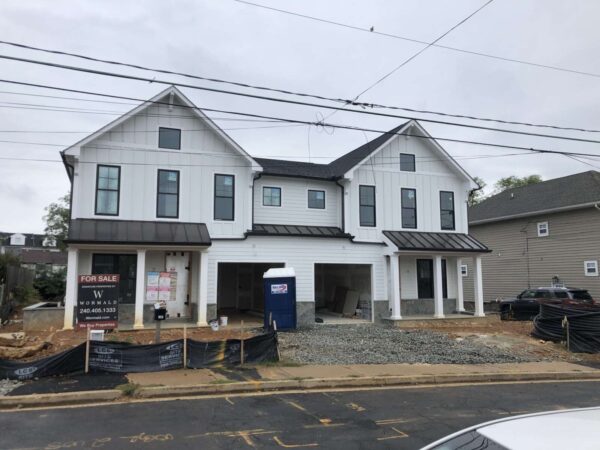
The Arlington County Board says a draft version of zoning changes that could allow Missing Middle housing types includes provisions that respond to community concerns raised this fall.
After contentious meetings this summer, the county hosted community conversations and information sessions to gather more feedback from residents and share more information about its proposal to allow “middle housing” types — ranging from duplexes to eight-plexes — in districts zoned for single-family homes.
The new draft document, released Monday night, allows the by-right construction of duplexes, three-unit townhouses and multifamily buildings with up to eight units on lots no larger than one acre in districts currently only zoned for single-family homes. (Lots greater than one acre would require the county’s site review process that incorporates public hearings.)
The new additions address the number of units allowed per lot, parking requirements, tree loss and the overall impact of Missing Middle on the pace of redevelopment, per a County Board letter to the Planning Commission describing the draft.
“The input from so many members of the Arlington community has shaped the options for text amendments that are now before you for consideration,” the Board letter says. “The Phase 3 Preliminary Policy Approaches and Considerations — options which this text could effectuate — reflect key areas of community feedback.”
Now, the Arlington County Board is set to decide whether density should be determined by the size of the lot, or if all lots should allow up to eight-unit buildings, as long as the building footprint does not exceed a certain level.
Missing Middle proponent Jane Green, representing YIMBYs for Northern Virginia, said the tiering proposal “is reasonable and codifies what would mostly happen based on the reality of building code restrictions.”
Another proponent, a longtime housing researcher Michael Spotts, said in a thread on Twitter that he prefers allowing eight-unit buildings everywhere, but the tiered option “seems flexible enough to enable MM while addressing concerns about massing on smaller lots.”
Regarding parking, there are new limits placed on the number of spots required per building that vary based on proximity to transit and whether the building is on a cul-de-sac.
The draft text would require at least .5 parking spaces per unit within a certain distance of transit, and at least one parking space per unit for dwellings on a cul-de-sac, regardless of proximity to transit.
For advocates, that’s too much parking. Spotts noted he thinks the parking standards are “a bit too high,” but, he added, “I like that they allow for administrative approval for off-street parking reductions if on-site parking is available. ”
This marks a departure from other municipalities that have already approved Missing Middle housing. Both Portland and Minneapolis removed parking minimums to encourage construction of these housing types.
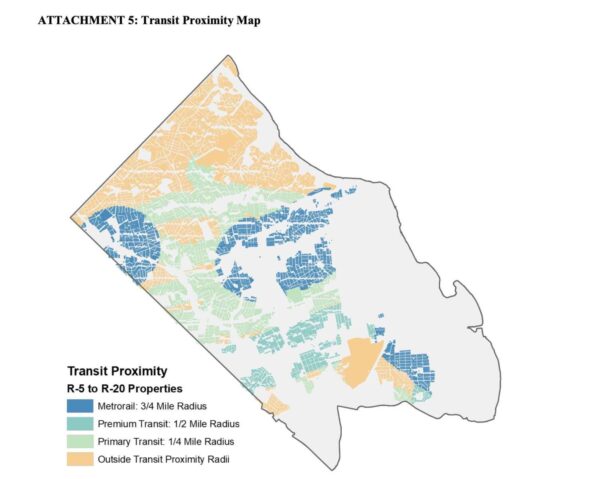
As for trees, the draft proposes requiring at least one tree for every dwelling unit on a lot.
While Green and Spotts said the provision on trees highlights the county’s willingness to listen and change, Missing Middle opponents are not so sure.
“The new draft Missing Middle plan shows that the County Board is listening to its critics,” Green said. “It provides options that address tree canopy, the potential of limiting higher unit buildings to larger lots and adjusting parking requirements by proximity to transit.”
Anne Bodine, of Arlingtonians for Our Sustainable Future, which opposes the proposal, said “it sounds good at first glance, but I’m not sure how it clicks with” state tree planting requirements.
Lastly, regarding the limits on the pace of development, staff have included “placeholder” language floating the idea of annual caps on development or neighborhood-based caps to prevent high concentrations of projects in some areas and little change in others.
That responds to concerns that neighborhoods with relatively less expensive homes and land values, such as Halls Hill, will see more development than more expensive neighborhoods further north.
But YIMBYs of NOVA is urging the county to adopt options providing “the fewest barriers to building new housing,” Green said.
“In particular, the County should reject options that allow caps on the number of units per year,” she said. “Addressing our housing crisis cannot wait.”
The parking garage over I-66 near Ballston is falling apart and needs repairs, says the Virginia Department of Transportation.
The garage sits above I-66 between N. Stafford and Quincy streets, next to Washington-Liberty High School. It serves as the primary parking area for the school and is the site of a seasonal flea market, called the Arlington Civitan Open Air Market.
VDOT has launched a public engagement period to brief locals on the garage’s deteriorating condition and the $2.7 million in planned improvements. Through next Monday, Nov. 7, people can provide comments online in a survey and by email or postal mail.
The Commonwealth seeks public input on repairing and rehabilitating the parking garage over I-66 at Washington-Liberty HS. And yes, galvanic cathodic protection is on the menu. https://t.co/dZQmSIbbWl pic.twitter.com/ZSWuwTpuN7
— Arlington Department of Environmental Services (@ArlingtonDES) October 28, 2022
The state transportation department says it aims to minimize traffic disruptions and keep most parking spaces available during construction. VDOT expects to send out the project for bid next summer and to start work in the fall of 2023, with construction wrapping up in about six months.
“The purpose of this project is to address various conditions identified through routine inspections that are likely to deteriorate further if not repaired soon,” a VDOT staff member said in a presentation. “Delaying action could allow some of them to become critical requiring much more extensive, expensive and disruptive repairs down the road. The repairs will ensure the structure remains safe for all users for years to come.”
The garage was built in 1982, and since then, there has been no major work performed beyond routine maintenance, VDOT Communications Coordinator Mike Murphy tells ARLnow.
After 40 years of exposure to the elements — including cycles of freezing and thawing, anti-icing salts, and high temperatures — the garage’s columns and surfaces are worse for wear, according to the state transportation department’s presentation. The presenter said these signs of deterioration are typical of structures this age.
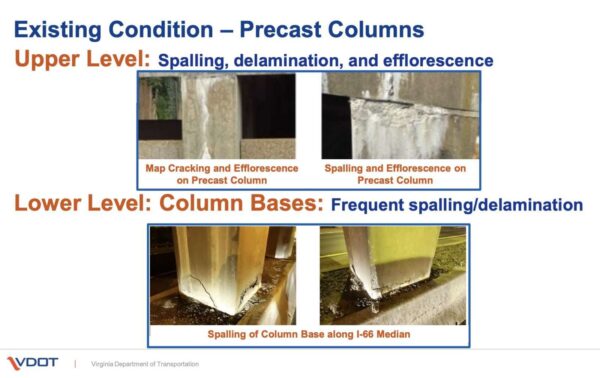
Some columns on the garage’s lower level need significant repairs to ensure its structural integrity, the presenter said. Leaking water has caused the reinforcing steel within the concrete to corrode, causing the concrete to break in flakes.
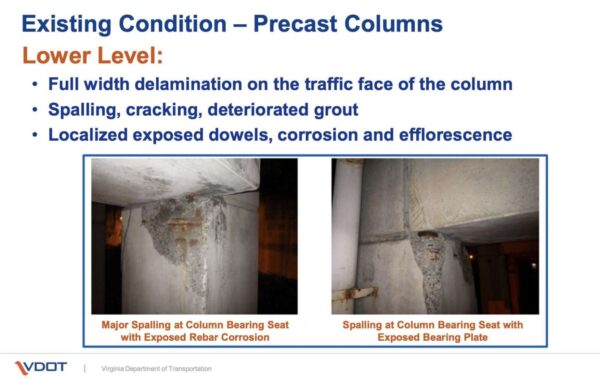
In one phase of the project, traffic lanes on I-66 will be shifted to the outside lane and the shoulder to allow work along the median, per the presentation. Lane closures are expected to be limited to single lanes.
“The majority of repair work occurs on the lower level along I-66, which is isolated from parking areas of the garage,” the VDOT staff member said. “There will be no changes to local traffic patterns or pedestrian flow on N. Quincy Street, N. Stafford Street, or 15th Street N.”
No impacts to the Custis Trail — which runs parallel to I-66 under the garage — are anticipated at this time, Murphy said.
(Updated at 3:50 p.m.) The Missing Middle housing debate fueled a tense confrontation and a spat over campaign financing during the Arlington County Board meeting Saturday.
Leading up to the meeting, proponents and opponents rallied outside of county government headquarters in Courthouse. Advocacy group leaders spoke to attendees and NBC 4 over the clang of construction on a new apartment building across the street.
The County Board is gearing up to consider whether to amend the zoning code to allow for buildings with two to eight units on lots that are currently zoned only for single-family detached homes. The Planning Commission and County Board could consider amendments to the proposal over the next few months.
Proponents say the move would give homebuyers more choices in more neighborhoods in a broader range of prices, and help undo the lasting impacts of historically racist zoning policies. Opponents counter these changes will actually displace lower-income residents, won’t decrease home prices, will reduce Arlington’s tree canopy and strain its infrastructure and schools.
In the County Board room this weekend, a resident interrupted the conclusion of an anti-Missing Middle speech to hand each County Board member a rolled-up, printed-out copy of a petition opposing the changes, which had more than 4,460 signatures as of publication.
“No, no — sir, sir, sir — excuse me, please, please, please don’t approach the Board,” said a distressed and frustrated sounding Board Chair Katie Cristol. “Please, can you please go to our Clerk? Sir? Thank you.”
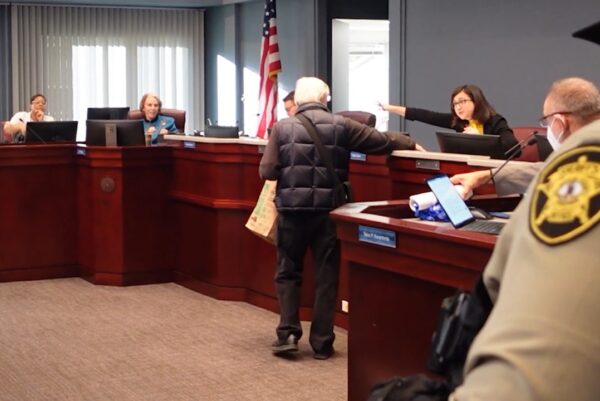
Missing Middle advocate Charles Day then took the podium to say that the status quo — redevelopment of starter homes into larger, multi-million-dollar homes — increases competition for existing market-rate affordable housing, like the garden apartment on Columbia Pike he and his wife live in, thus displacing lower-income families.
“It’s not lost on us that because of lack of starter homes, couples like us are taking up an apartment that a lower-income family might need,” he said. “Unfortunately, most young people don’t have a lot of options… There’s no silver bullet to solve the housing crisis overnight but rents continue to rise and the starter home is becoming a thing of the past.”
After him, independent County Board candidate Audrey Clement, speaking via Zoom, took a shot at the Sun Gazette’s endorsement of her opponent, incumbent Matt de Ferranti. She argued that de Ferranti supports Missing Middle because he’s taking money from construction workers.
“About $50,000 of de Ferranti’s large donor intake is from people and organizations outside the county, mostly outside the state, including $13,500 from construction trade unions destined to benefit from the Missing Middle building boom,” she said. “If the donations from those with no vested interest in the county were subtracted haul, his receipts would shrink to $19,000 and the election would be more competitive.”
According to Virginia Public Access Project, de Ferranti has received roughly $15,000 this year from unions representing construction workers, around the same amount as he received from a single, billionaire-funded education nonprofit.
De Ferranti said he refuses donation from developers and that donations from unions do not change his policy stances.
“I don’t take a dime from developers. In fact, a couple of weeks ago, I learned that one donation that was submitted online had an association with a developer — and I returned it,” de Ferranti said in response. “I have no promises to any of the unions, I merely seek to fight for working people. Let’s have a debate on policy, let’s have a debate on equity, let’s do it civilly, please.”
Arlington County is asking locals if they like Covid-era outdoor dining and want it to stay post-pandemic.
One central question in a recently-posted survey is where permanent outdoor dining areas would go. Top contenders appear to be streets, parking spaces and parking lots, according to the survey, which asks respondents if they’re comfortable ceding some parking to outdoor dining experiences.
This feedback form, available online through Friday, Oct. 28, is part of Arlington’s Future of Outdoor Dining Study — appropriately dubbed the “FOOD Study.” The study, first discussed last fall, is the latest step forward for the open-air eating movement, which gained traction during the pandemic.
“The FOOD Study will look at lessons learned from [temporary outdoor restaurant seating areas] and identify recommended amendments to the Zoning Ordinance and Outdoor Café Guidelines to strike an appropriate balance between commercial resiliency and public and community interest,” the webpage said.
In 2020, the Arlington County Board approved a temporary way for restaurants to circumvent the normally lengthy bureaucratic process for getting an outdoor dining permit. Many restaurants debuted these Temporary Outdoor Seating Areas (TOSAs) to make up for lost revenue due to social distancing requirements and diners skittish of indoor spaces, giving guests an arguably safer dining experience in the process.
Since then, the County Board has expanded and molded the ordinance to changing circumstances.
In December, the Board granted restaurant and bar owners the ability to set up TOSAs in common areas, such as plazas. When capacity restrictions were lifted in the spring of 2021, the County Board gave restaurants a way to request temporary certificates of occupancy for their TOSAs so they could operate the seating areas while operating at full capacity indoors.
Now, the county is examining whether it should allow local restaurants to expand their outdoor dining areas on both private and public property permanently, according to the county website.
For instance, the study will look at how much private parking space and public right-of-way cafés should take up, and whether those on private property could continue operating with administrative approval, while those operating in public spaces would need County Board approval.
“Given the public interest, outdoor cafés in public rights-of-way generally face stricter requirements,” the website says. “This approach helps ensure sidewalks continue to serve mobility needs of the public or recreation needs of those enjoying public spaces and aims to protect other community interests and avoid adverse impacts.”
Permanent outdoor dining areas may end up in competition with another in-demand amenity: private parking provided by the restaurant. Currently, county zoning ordinances require one parking space for every six seats in restaurants that are more than 1,000 feet from a Metro station.
A dent in parking might not impact the majority of TOSAs, many of which are concentrated in Metro-accessible areas, such as the Rosslyn-Ballston corridor and in Crystal City and Pentagon City, per a map of existing TOSA locations.
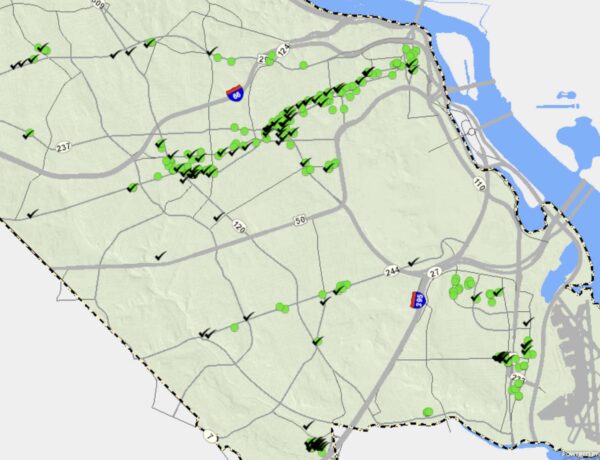
But parking spaces have enough potential that the survey asks respondents what safety features would encourage them to eat in street parking zones or in a parking lot, such as traffic barriers, planters, reflective features and tents.
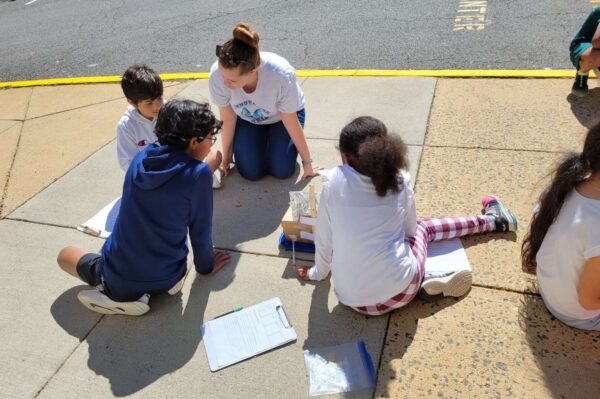
A few hundred parents say Arlington Public Schools should prioritize recreating pre-Covid normalcy in the classroom and evaluating the use of electronic devices.
That’s according to a recent informal survey conducted by Arlington Parents for Education, a parent group that began during the pandemic to advocate for reopening schools.
Since schools reopened, APE has evolved into a School Board watchdog group, with priorities such as reversing pandemic-era learning loss. The group says the survey will inform what APE should advocate for, in addition to ending Covid protocols. The priorities don’t surprise School Board candidates and other education advocacy groups, but some groups say the survey does not speak for the parents they represent.
The survey netted a few hundred responses, about 70% of which reside in North Arlington and a little under 30% in South Arlington, with some respondents living outside the county. Most have elementary-aged children, followed by children in middle and high school. Some also indicated they had children in area private schools, which saw an influx in public school families when they returned for in-person school before APS.
“We recently surveyed hundreds of our parents to see how their students are doing in a post-pandemic world at APS and what they want APS and APE to focus on,” APE said in a statement. “Overwhelmingly, parents want a return to normalcy for their students — full resumption of field trips, in-person orientations, back-to-school events and other parental involvement opportunities in all APS buildings.”
“This also means returning to the pre-pandemic golden rule applicable to any illness: if you’re sick, stay home,” the group added.
APS is, in fact, returning to pre-Covid procedures for field trips and events, APS spokesman Frank Bellavia said.
Masks became optional as of March 1, but students, visitors and teachers have some Covid protocols to follow.
Those with Covid-like symptoms must present a negative test or alternative diagnosis from a medical provider or isolate at home for five days before returning to class. Meanwhile, volunteers, like APS employees, must have proof of vaccination or undergo weekly testing to volunteer, Bellavia said.
For APE, that’s not normal. But for Smart Restart APS, a parent group that started to push for protocols such as outdoor lunch and improved ventilation, said there is no return to life pre-2020.
“Smart Restart APS believes we are living in a new reality, and APS should continue to have appropriate, common-sense measures to adapt to living in this new reality, one which includes the ever-present possibility of COVID-19 infection spreading through our schools,” the group said in a statement. “We have to adapt — not ignore — the new situation.”
The spread of Covid still impacts families, whether a parent misses work or a child brings home Covid to a high-risk family member, the group continued.
“Everyone has a right to access a safe and healthy school environment,” the Smart Restart statement said. “COVID-19 in the air should not be a part of that.”
(Updated 09/30/22) As Arlington County continues collecting feedback on the preliminary concept plan to turn Langston Blvd into a “Green Main Street” over several decades, a few disagreements have emerged.
Some say county staff need to coordinate more with existing plans for two neighborhoods along Route 29, as well as the Missing Middle Housing Study. Others say the building heights should be taller — to allow for more affordable housing — or are too tall already.
Late in August, Arlington County released a draft plan showing what Langston Blvd, formerly Lee Highway, could look like if the county encouraged denser housing and more walkable, greener streets, and planned for future infrastructure, transportation and facility needs. Since then, the county posted an online feedback form and launched in-person feedback opportunities called Design Studio sessions and virtual neighborhood meetings.
More than 200 people have attended the three virtual community meetings and Design Studio sessions, and more than 200 people have responded to the feedback forms, Rachel LaPiana, a staff member with the Department of Community Planning, Housing and Development, tells ARLnow.
“We encourage the community to provide feedback on a set of specific questions about what is proposed in the PCP and attend one of the upcoming community events,” she said.
There are still a number of opportunities to learn more about Plan Langston Blvd and provide feedback, which staff will collect through early November. This Saturday, the Langston Boulevard Alliance will host a walking tour, during which county planners will be able to answer questions. Another tour will be held on Sunday, Oct. 16.
The Langston Boulevard Alliance is also hosting three Design Studio sessions, held from 12-2 p.m. on Friday, Oct. 7 and 21 and Nov. 4 at its office (4500 Langston Blvd). A fourth virtual community meeting discussing housing, stormwater and transportation will be held Tuesday, Oct. 11, from 7-9 p.m.
It’s too soon to summarize the substance of the feedback that has been collected, LaPiana said.
“Once the engagement period ends, we will compile and analyze all of the community feedback,” she said.
Differing takes have since surfaced during a debate for County Board candidates held by the Arlington Chamber of Commerce, as well as during this month’s County Board meeting.
“I’ve largely heard muted feedback, and that is not always the case with plans,” said County Board member Matt de Ferranti, who’s running for re-election this November, during the debate earlier this month. “I have heard a number of compliments. I actually think the plan is in decent shape.”
But, he said, the plan challenges the county’s ability to advance multiple planning fronts simultaneously, including the controversial Missing Middle Housing initiative, in which the county is considering whether to allow townhouses, duplexes and other low-density housing types in residential areas zoned exclusively for single-family homes.
“We have to, at least in my view, do them separately, because we can give our community full chance for engagement,” he said.
Independent candidate Audrey Clement questioned why upzoning is needed at all, with the bevy of new housing units proposed in Plan Langston Blvd and envisioned in the approved Pentagon City Planning Study, which, like Plan Langston Blvd, calls for significant, mostly residential redevelopment and more designated green spaces.
“We have something called a siloed process, where we have three plans, each ignorant of each other, that will increase housing on a massive schedule. That doesn’t make sense,” Clement said. “These plans should not be developed in a vacuum, but that appears to be what is happening right now.”
East Falls Church homeowner Wells Harrell told the County Board this month that Plan Langston Blvd ought to examine why development has lagged in East Falls Church and Cherrydale, despite the fact both underwent planning efforts in 2011 and 1994, respectively.
“Metro today remains surrounded by parking lots at the East Falls Church Metro station, and so far, there’s only been one — one — residential development since the plan was adopted in 2011,” Harrell said. “We need to take stock of why we haven’t achieved the goals set forth in the Cherrydale and East Falls Church area plans… in order to not just learn from the lessons we had there, but to guide us going forward and make sure we achieve the visions for Langston Blvd.”
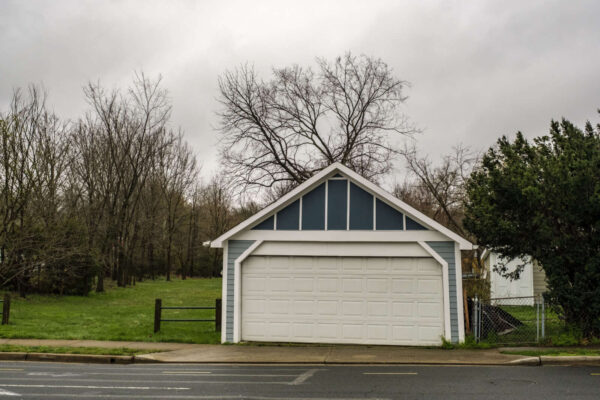
County planners previously told ARLnow that they need the County Board’s go-ahead to revisit the East Falls Church plan. Further discussion about encouraging development in the area could come after the Board adopts a final Plan Langston Blvd document.
For now, plan authors say a final Plan Langston Blvd draft will recommend whether the existing redevelopment roadmaps for East Falls Church and Cherrydale need to be reviewed and refined.
Building heights are another source of disagreement. Plan authors write that building heights were lowered in response to some critical community feedback. That criticism also suggested the changes would diminish the stock of market-rate affordable apartments, lower property values, change neighborhood character and push out small businesses.
County staff say that lower heights may satisfy some residents, but it will slow down redevelopment.
“Staff believes the proposed concept plan will offer incentives for redevelopment, however, the levels are only moderately different from what is allowed for by-right development and site plan projects,” county planner Natasha Alfonso-Ahmed said in a video introducing the plan. “This means that we may see more by-right development, and improvements such as streetscape enhancements may take longer to be realized or happen in a fragmented way.”
And the changes dismayed pro-density advocates, including Harrell and independent County Board candidate Adam Theo.
“I am disappointed to see that the most recent draft has scaled a lot of that back,” Theo said.
De Ferranti, meanwhile, says there is one neighborhood where the heights may still be “a touch too high” — the area near Spout Run Parkway, where plan calls for buildings 12-15 stories tall.
“That decision is one we have to engage as a community on,” he said.
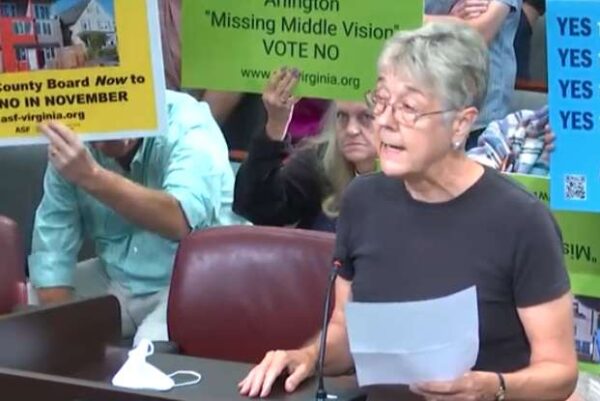
In a crowded Bozman Government Center on Saturday morning, one person urged the Arlington County Board to move forward with Missing Middle housing while another critiqued the push for county-wide zoning changes.
But Board members had only to read the room — and the signs people brought — to see a sea of residents who were as divided into pro- and anti-Missing Middle camps that day as they were during a raucous meeting this June.
“We owe it to our larger community to let more people live here through smaller multiplexes, yes, but especially through denser affordable apartment housing. Doing otherwise is environmentally unsustainable — and it’s exclusionary,” said Susan English. “I’ve lived in a pleasant tear-down in a nice neighborhood for 40 years, but I hope when I leave my house will be replaced with at least a duplex.”
Independent County Board candidate Audrey Clement, the only candidate opposed to the Missing Middle upzoning proposal, told those attending and watching the meeting that she would “debunk some myths about it.”
Reciting excerpts of a speech she has presented during the Arlington County Civic Federation and Chamber of Commerce candidate fora, Clement argued that Missing Middle will not add to the county’s stock of 3-bedroom, and will reduce Arlington’s tree canopy, and will not increase home-buying opportunities for people of color — though the latter is an assertion with which the local NAACP disagrees.
Clement suggested alternatives such as office-to-residential conversions.
Board Chair Katie Cristol broke through the whooping and hollering that followed Clement’s comments, saying, “Alright, thank you ladies and gentlemen, we’re going to continue hearing from neighbors.”
But she later thanked attendees for respecting the rules for addressing the Board, which include restrictions on how many people can speak on a given matter not otherwise on the Board’s agenda.
“I also just want to give a sincere thanks to all who’ve come who respected our one-speaker-per-topic rule, helping us hear from more neighbors,” she said.
During the June meeting, some attendees shouted at Cristol when she cut off another speaker for violating the rule. The Board allows one speaker per topic, with opposing views on the same topic considered two separate topics.
Booing, which followed a speech this summer by a member of pro-density group YIMBYs of Northern Virginia, was also absent this time around. But there was plenty of applause — for every speaker, despite the range of topics, from the taxes nonprofits pay to climate change.
Resident Dima Hakura, who has spoken at length in meetings and with the Board about the Courthouse West General Land Use Plan, took the podium to urge the County Board to listen to its constituents, not “patronize us.” The room erupted in cheers after she finished her speech.
We need a leadership that builds consensus among us and unites us. A leadership that not only respects our opinions and values them, but also taps into them. One that considers our thoughts and makes constructive use of them to evolve the solutions possible… Interestingly, Arlington was always known for that, but somehow, somewhere we lost our way and we need to find it again.
… When I told people I was coming to speak before you today, the reaction was: “Why bother?” or, “It’s not going to make an iota of difference,” or, “Their mind is already made up. They have an agenda they want to push.” Regardless, I am hoping differently.


